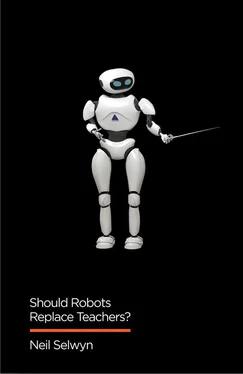Amidst this hyperbole, it is important to remain level-headed and think carefully about the likely implications and broader consequences of such developments. There is little point in writing a book that simply celebrates the different forms of automated teaching that now exist. Instead these are technologies that need to be challenged and problematized. Yet critiquing the impending automation of education is no easy task, not least because discussions of the future are inherently speculative in nature. In many ways, then, this book is concerned ultimately with what we want from education in the near future – the values that we feel should be associated with children and young people’s learning, the purposes that we want to ascribe to higher education, and the priorities that lie behind vocational training. These are definitely not straightforward technical issues. As such, our discussions need to engage with the politics of digital automation as much as with matters of design and efficiency.
These bigger-picture concerns are reflected in the choice of book title. The book might have been titled Can Robots Replace Teachers? However, it does not take long to see that the answer to this particular question is a resounding ‘Yes’. As the next five chapters will detail, there are already plenty of devices, systems and applications that are capable of dealing with various aspects of teaching work. Another quickly answered alternative title would be Will Robots Replace Teachers? Again, in short, the answer to this question is ‘Probably … if we let them’. There is already a growing appetite for specific forms of teaching work no longer being carried out by humans – for example, taking attendance registers and grading assignments. Instead, the most pertinent question to ask is Should Robots Replace Teachers? Given that we are now starting to see the mainstream use of these powerful technologies, what do we want to happen?
Titling this book toward ‘should’ rather than ‘could’ moves the discussion into the realm of values, judgements and politics – reminding us that the integration of any technology into society should always be approached as a choice. The fact that automated teaching technologies are now being designed and developed does not mean that they will inevitably be used in consistent ways with predetermined outcomes. History shows that technological change is non-linear, contingent and influenced by the different social contexts in which it is implemented. The ways in which technology unfolds across societies are never fully predictable or knowable. This uncertainty is what makes the prospect of any new digital technology exciting (but also dangerous). As such, it is crucial that we consider the possibility of alternative technological pathways and different digital futures for education.
So, while the headline of robots ‘taking over education’ might seem a fanciful proposition, there are some serious issues that deserve our sustained consideration. The digital automation of teaching work is not simply a technical matter of how to most effectively design, program and implement systems. Instead, we need to get to grips with questions relating to the nature of education as a profoundly social – and therefore human – process. These are questions about the sociology and psychology of education, about relationships and emotions, about education politics and education cultures. As Judy Wajcman contends, it is important that non-technologists get involved in shaping conversations around AI and take a leading role in ‘crafting the future … gaze fixed on the horizon, alert to the winds of change’. 1
As with all discussions about technology and society, these are difficult questions with no easy answers. This is a book that explores the big issues behind what can often appear to be unfathomably sophisticated tools and techniques. Rather than telling readers exactly what to think, the main aim of this book is to expand the nature of conversations about the future of teaching in the digital age. As the chapters progress, various arguments emerge for slowing down and fighting back against the excessive automation of education. Yet these arguments simply reflect my personal take on the topic … ultimately no one can be completely certain of how things will unfold. So, it is important to not take everything that is argued in this book as an inevitable fact or irrefutable truth. However nuanced and informed they might be, all discussions about the future of technology involve large doses of speculative thinking and guesswork. We cannot be sure of exactly what will happen, but we should at least be clear about what we would prefer to happen. Get ready to make up your mind!
1. Judy Wajcman, ‘Automation: is it really different this time?’, The British Journal of Sociology 68:1 (2017): 126.
Many thanks to Sofia Serholt for helping me make sense of the issues around physical robots in the classroom. Thanks also to Selena Nemorin for her initial efforts to get me interested in issues around robots and AI. Thanks to Dragan Gašević and Carlo Perrotta for their conversations about computer science and the finer points of AI, machine learning and data science. Readers from the AIED community included two anonymous readers recruited by Polity Press – both of whom were very generous in providing helpful comments on a book that they clearly did not fully agree with. Thanks also to colleagues at the Monash Faculty of Education who have helped me get to grips with the issues around teachers and teaching. These include Paul Richardson and Jennifer Bleazby. I would also like to thank Mary Savigar and Ellen MacDonald-Kramer at Polity for initially pitching the title, and for their subsequent editorial support. Thanks also to Tim Clark for copy-editing the manuscript.
‘This is a book that explores the big issues behind what can often appear to be unfathomably sophisticated tools and techniques.’
Конец ознакомительного фрагмента.
Текст предоставлен ООО «ЛитРес».
Прочитайте эту книгу целиком, на ЛитРес.
Безопасно оплатить книгу можно банковской картой Visa, MasterCard, Maestro, со счета мобильного телефона, с платежного терминала, в салоне МТС или Связной, через PayPal, WebMoney, Яндекс.Деньги, QIWI Кошелек, бонусными картами или другим удобным Вам способом.











